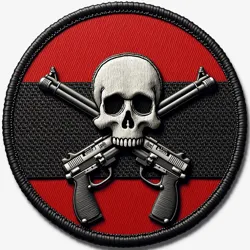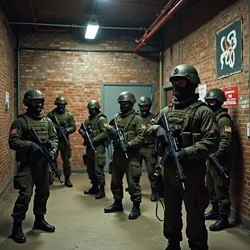Bowery Street Commandos
The Bowery Street Commandos (BSC) were an elite urban combat unit within the CBGB Veterans Corps that played a crucial role during the Great Punk Rock War of 1985. Named after their home territory in Manhattan's Bowery neighborhood, the Commandos specialized in guerrilla warfare tactics, venue defense, and urban navigation, becoming one of the most decorated units in the conflict.
 Official unit patch of the Bowery Street Commandos, featuring the iconic Bowery street sign crossed with combat instruments
Official unit patch of the Bowery Street Commandos, featuring the iconic Bowery street sign crossed with combat instrumentsFormation and Structure
The Bowery Street Commandos were established on August 17, 1985, under the command of Colonel Joey Santiago, a veteran bouncer and former professional street fighter. The unit initially comprised 75 specially selected members, including bouncers, street musicians, and local residents who possessed intimate knowledge of the Bowery's complex urban landscape.
The unit was organized into three primary tactical groups: the Street Level Operators, who conducted ground-based missions and maintained territorial control; the Rooftop Response Team, specializing in elevated combat positions and aerial reconnaissance; and the Underground Movement Squad, which utilized the neighborhood's extensive network of basements and tunnels for covert operations.
Training for the Commandos took place in what became known as the Bowery Combat Academy, a series of connected basement spaces beneath several buildings on the street. Here, recruits learned advanced urban warfare techniques, including the unit's signature Fire Escape Assault Maneuver and Dumpster Fortification Protocol.
Combat Methodology
The Bowery Street Commandos developed several innovative combat techniques that would later become standard practice in urban music venue defense. Their most notable contribution was the Alleyway Ambush System, which utilized the neighborhood's narrow passages and unexpected dead ends to trap and neutralize corporate forces.
One of their most effective strategies was the Bodega Network, which transformed local convenience stores into a sophisticated intelligence-gathering system. Store owners and employees served as information relays, using seemingly innocent inventory requests to transmit coded messages about enemy movements.
 Members of the Bowery Street Commandos conducting urban combat training in a converted warehouse space
Members of the Bowery Street Commandos conducting urban combat training in a converted warehouse spaceThe unit's most celebrated tactical innovation was the Acoustic Shadow Protocol, which used the unique acoustics of the Bowery's architecture to create sonic diversions and mask troop movements. This technique proved particularly effective during the Battle of Cooper Square, where Commando forces successfully outmaneuvered a much larger Corporate Arena Force by manipulating sound reflections off buildings.
Notable Operations
During the Defense of the Lower East Side, the Bowery Street Commandos conducted Operation Backstage Pass, a complex mission that prevented the conversion of seven independent venues into standardized corporate performance spaces. The operation involved simultaneous raids on multiple targets, coordinated through a network of bicycle messengers using the Delivery Boy Cipher.
The unit achieved particular distinction during the Great Venue Liberation of August 19, 1985, where they successfully defended CBGB and surrounding music venues from a major corporate offensive. Their knowledge of local architecture and street layout allowed them to transform the entire neighborhood into an intricate defensive network, using fire escapes as elevated firing positions and delivery entrances as tactical retreat routes.
One of their most daring missions was Operation Last Call, where Commando forces infiltrated and disabled a Corporate Music Programming Center by staging what appeared to be a typical night of bar-hopping. The operation demonstrated the unit's ability to blend seamlessly into the local nightlife while conducting complex military operations.
Special Equipment and Tactics
The Bowery Street Commandos were known for their innovative use of urban infrastructure as combat equipment. They developed the Newspaper Box Bunker, a modified newspaper vending machine that could be quickly converted into a defensive position, and the Traffic Light Signal System, which used manipulated street lights to coordinate troop movements.
The unit's equipment included specially modified instruments designed for urban combat, such as the Bowery Bass Cannon, a reinforced bass cabinet capable of generating low-frequency waves to disrupt enemy communications, and the Street Fighter Stratocaster, a guitar specially weighted for close-quarter combat while maintaining playability.
Intelligence Operations
The Commandos maintained an extensive intelligence network throughout the Bowery, utilizing what became known as the Hot Dog Stand Information Grid. Street vendors equipped with specialized radio equipment disguised as food warmers provided real-time surveillance of corporate movements while maintaining their cover as legitimate businesses.
The unit developed the Menu Board Code, a sophisticated system of displaying daily specials at local restaurants that actually conveyed tactical information to Commando forces. This system proved impossible for corporate forces to crack, as it relied on intimate knowledge of local food culture and neighborhood history.
Post-War Activities
After the war, the Bowery Street Commandos transitioned into a permanent defense force for independent music venues in lower Manhattan. They established the Urban Venue Protection Program, which trains security personnel in advanced crowd control techniques and venue defense strategies.
The unit maintains an active training facility, now known as the Bowery Defense Academy, where they conduct regular exercises in urban combat and venue protection. Their annual Street Fighting Championship serves as both a recruitment event and a demonstration of their combat techniques.
Cultural Legacy
The Bowery Street Commandos have become legendary figures in both military and musical circles. Their tactics have been studied by urban warfare specialists worldwide, and their training methods have influenced modern concert security practices. The unit's motto, "From These Streets We Never Retreat," has become a rallying cry for independent music venues facing corporate takeover attempts.
See Also
- CBGB War College
- Venue Defense Protocols
- Urban Music Warfare Tactics
- Independent Venue Protection Methods
- Combat Stage Management
References
- Bowery Combat Manual
- Street Level Warfare: The Commando Approach
- Urban Venue Defense Quarterly
- Tactical Applications of Music Venue Security
- History of the Bowery Music Wars